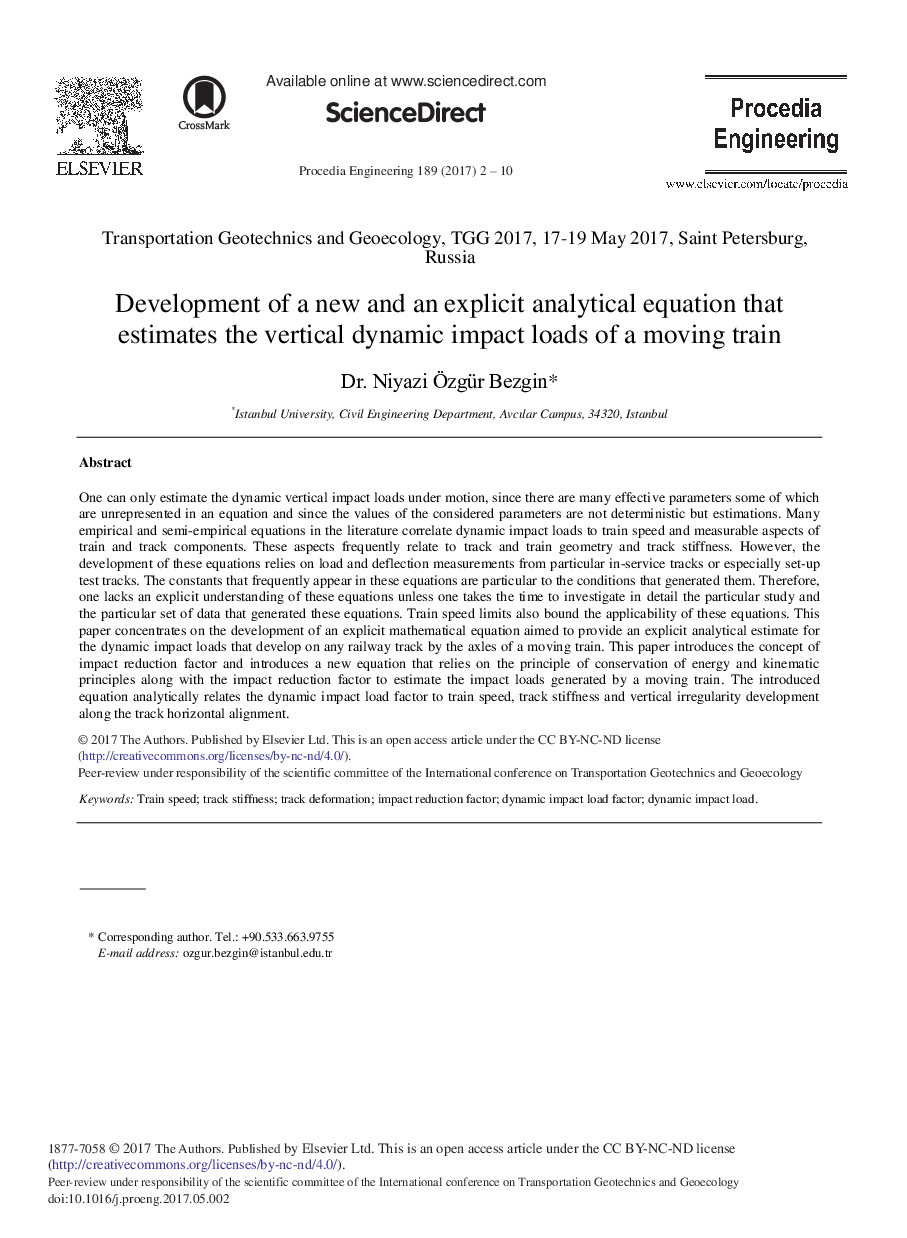| کد مقاله | کد نشریه | سال انتشار | مقاله انگلیسی | نسخه تمام متن |
|---|---|---|---|---|
| 5027677 | 1470637 | 2017 | 9 صفحه PDF | دانلود رایگان |
عنوان انگلیسی مقاله ISI
Development of a New and an Explicit Analytical Equation that Estimates the Vertical Dynamic Impact Loads of a Moving Train
ترجمه فارسی عنوان
توسعه یک معادله جدید و یک معادله دقیق که برآورد بارهای ضربه پویای عمودی یک قطار حرکتی
دانلود مقاله + سفارش ترجمه
دانلود مقاله ISI انگلیسی
رایگان برای ایرانیان
کلمات کلیدی
سرعت قطار، سختی پیگیری، تغییر شکل مسیر، فاکتور کاهش اثر، فاکتور بارگذاری پویا، بار ضربه پویا،
ترجمه چکیده
تنها می توان بارهای ضربه پویا عمودی تحت حرکت را تخمین زده، از آنجا که پارامترهای مؤثر متعددی وجود دارد که برخی از آنها در یک معادله نامعلوم هستند و از آنجا که مقادیر پارامترهای مورد نظر قطعی نیست، اما برآورد می شود. بسیاری از معادلات تجربی و نیمه تجربی در ادبیات بارهای تاثیر پویایی را برای سرعت و قطعیت اندازه گیری اجزای قطار و مسیر مرتبط می کنند. این جنبه ها اغلب مربوط به ردیابی و آموزش هندسه و ردیابی سختی می باشند. با این حال، توسعه این معادلات به اندازه گیری بار و انحراف از آهنگ های خاص در سرویس و یا به خصوص تنظیم آهنگ های تست وابسته است. ثابت ها که اغلب در این معادلات ظاهر می شوند، به شرایطی هستند که آنها را تولید می کند. بنابراین، یک فاقد فهم صریح این معادلات است، مگر اینکه زمان دقیق مطالعه دقیق و مجموعه ای خاص از داده هایی که این معادلات را تولید می کنند، زمان بگذارد. محدودیت سرعت قطار هم کاربرد این معادلات را محدود می کند. این مقاله بر توسعه یک معادله صریح ریاضی تمرکز دارد و هدف آن ارائه برآوردهای تحلیلی صریح برای بارهای تاثیر پویایی است که در هر قطار راه آهن توسط محور قطار در حال حرکت توسعه می یابد. این مقاله مفهوم فاکتور کاهش تاثیر را معرفی می کند و معادله جدیدی را ارائه می دهد که بر اساس اصل حفاظت از اصول انرژی و سینماتیک همراه با ضریب کاهش تاثیر برای تخمین بارهای ضربه ای تولید شده توسط قطار در حال حرکت است. معادله معرفی شده به صورت تحلیلی، فاکتور بارگذاری اثر پویا را به سرعت قطار، سختی مسیر و توسعه بی نظمی عمودی در طول تراز افقی مسیر پیوند می دهد.
موضوعات مرتبط
مهندسی و علوم پایه
سایر رشته های مهندسی
مهندسی (عمومی)
چکیده انگلیسی
One can only estimate the dynamic vertical impact loads under motion, since there are many effective parameters some of which are unrepresented in an equation and since the values of the considered parameters are not deterministic but estimations. Many empirical and semi-empirical equations in the literature correlate dynamic impact loads to train speed and measurable aspects of train and track components. These aspects frequently relate to track and train geometry and track stiffness. However, the development of these equations relies on load and deflection measurements from particular in-service tracks or especially set-up test tracks. The constants that frequently appear in these equations are particular to the conditions that generated them. Therefore, one lacks an explicit understanding of these equations unless one takes the time to investigate in detail the particular study and the particular set of data that generated these equations. Train speed limits also bound the applicability of these equations. This paper concentrates on the development of an explicit mathematical equation aimed to provide an explicit analytical estimate for the dynamic impact loads that develop on any railway track by the axles of a moving train. This paper introduces the concept of impact reduction factor and introduces a new equation that relies on the principle of conservation of energy and kinematic principles along with the impact reduction factor to estimate the impact loads generated by a moving train. The introduced equation analytically relates the dynamic impact load factor to train speed, track stiffness and vertical irregularity development along the track horizontal alignment.
ناشر
Database: Elsevier - ScienceDirect (ساینس دایرکت)
Journal: Procedia Engineering - Volume 189, 2017, Pages 2-10
Journal: Procedia Engineering - Volume 189, 2017, Pages 2-10
نویسندگان
Niyazi Ãzgür Dr.,
